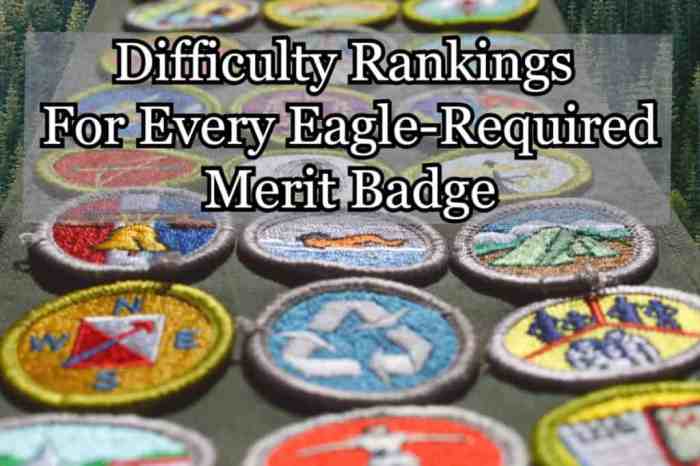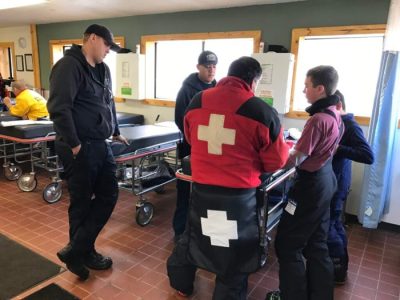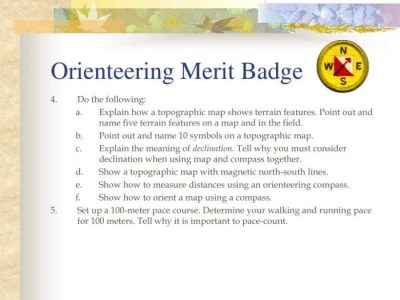In the realm of outdoor exploration, Scout navigation tools and compasses emerge as indispensable instruments, guiding scouts through uncharted territories and ensuring their safe return. These tools empower scouts with the ability to navigate with precision, interpret maps, and make informed decisions in the wilderness.
From understanding the basics of map reading to mastering the intricacies of orienteering, this comprehensive guide delves into the world of Scout navigation, equipping readers with the knowledge and skills to navigate confidently in any environment.
Navigation Tools for Scouts
Maps and compasses are essential tools for scouts, enabling them to navigate unfamiliar terrain safely and effectively. Maps provide a visual representation of the area, while compasses help determine direction and orientation.There are various types of maps available, including topographic maps, which show terrain features like elevation and contour lines; street maps, which depict roads and buildings; and aerial maps, which provide a bird’s-eye view of the area.
Compasses come in different forms, such as baseplate compasses, which have a rotating bezel and compass rose; lensatic compasses, which use a sighting mechanism; and digital compasses, which offer advanced features like GPS integration.To use maps and compasses effectively, scouts should familiarize themselves with map symbols and scales, as well as compass markings.
They should practice orienting the map and compass correctly, and using them together to determine their location and plan their route.
Types of Maps
*
-*Topographic maps
Show terrain features like elevation and contour lines.
-
-*Street maps
Depict roads and buildings.
-*Aerial maps
Provide a bird’s-eye view of the area.
Types of Compasses
*
-*Baseplate compasses
Have a rotating bezel and compass rose.
-
-*Lensatic compasses
Use a sighting mechanism.
-*Digital compasses
Offer advanced features like GPS integration.
Types of Compasses

In scouting, compasses are essential tools for navigation and finding directions. There are various types of compasses available, each with its advantages and disadvantages. Choosing the right compass depends on the specific scouting activities and the level of accuracy required.
Baseplate Compass
Baseplate compasses are the most common type used in scouting. They feature a rectangular baseplate with a rotating dial and a magnetic needle. Baseplate compasses are relatively inexpensive and easy to use, making them suitable for beginners and general navigation tasks.
Lensatic Compass
Lensatic compasses are more precise than baseplate compasses and are often used by experienced scouts and navigators. They have a magnifying lens that allows for more accurate readings and a sighting mechanism for precise alignment with landmarks.
Digital Compass
Digital compasses are electronic devices that display digital readings of direction and bearing. They are lightweight, compact, and can provide additional features such as altitude and temperature readings. Digital compasses are more expensive than traditional compasses but offer greater accuracy and convenience.
Choosing the Right Compass
The choice of compass depends on the intended use and the level of accuracy required. Baseplate compasses are suitable for basic navigation and general scouting activities. Lensatic compasses provide greater precision for more advanced navigation and orienteering. Digital compasses offer convenience and additional features but may not be necessary for all scouting activities.
Map Reading for Scouts

Map reading is an essential skill for scouts, enabling them to navigate unfamiliar terrain and plan their journeys effectively. Understanding the symbols and conventions used on maps is crucial for accurate interpretation.
Map Symbols and Conventions
Maps employ various symbols to represent different features, such as roads, water bodies, and vegetation. These symbols are standardized, ensuring consistency across different maps.
- Roads:Thin lines indicate roads, with thicker lines representing major highways.
- Water Bodies:Blue areas represent oceans, lakes, and rivers.
- Vegetation:Green areas denote forests, while lighter shades indicate grasslands.
Interpreting Maps
Accurately interpreting maps requires attention to detail and an understanding of scale. Scale refers to the ratio between the map and the actual terrain. It helps determine the distance between two points on the map.
- Scale:Maps often have a scale bar or statement indicating the scale, such as 1:25,000, meaning one unit on the map represents 25,000 units on the ground.
- Contour Lines:Contour lines connect points of equal elevation, providing information about the terrain’s shape and slope.
- Legend:Maps typically include a legend that explains the symbols and colors used.
Orienteering with Navigation Tools
Orienteering is the art of navigating unfamiliar territory using a map and compass. It is a popular sport that can be enjoyed by people of all ages and abilities. Orienteering can also be a valuable skill for hikers, campers, and other outdoor enthusiasts.
To get started with orienteering, you will need a map, a compass, and a whistle. The map will show you the layout of the terrain, including the location of checkpoints. The compass will help you determine your direction of travel.
And the whistle will help you signal for help if you get lost.
Once you have your gear, you can start planning your orienteering course. The first step is to choose a map that is appropriate for your skill level. If you are new to orienteering, start with a map that is relatively simple.
As you gain experience, you can move on to more challenging maps.
Once you have chosen a map, you need to decide on a route. The best way to do this is to look at the map and identify the checkpoints that you want to visit. Once you have identified the checkpoints, you can start planning your route.
When planning your route, it is important to consider the following factors:
- The distance between the checkpoints
- The terrain that you will be crossing
- The weather conditions
Once you have planned your route, you are ready to start orienteering. The first step is to find the starting point. Once you have found the starting point, you can start navigating to the first checkpoint.
To navigate to a checkpoint, you will need to use your map and compass. The map will show you the direction of travel, and the compass will help you stay on course.
As you navigate to the checkpoint, it is important to pay attention to your surroundings. Look for landmarks that you can use to help you stay on course. And be sure to check your map and compass regularly to make sure that you are on the right track.
Once you have reached the checkpoint, you can check in and then start navigating to the next checkpoint. Repeat this process until you have completed the course.
Orienteering is a great way to get exercise, enjoy the outdoors, and learn a valuable skill. If you are looking for a new challenge, give orienteering a try.
Safety Considerations When Using Navigation Tools

Navigation tools, such as compasses and GPS devices, can be invaluable when navigating in the wilderness. However, it is important to take certain safety precautions when using these tools to avoid getting lost or injured.
One of the most important safety considerations is to always carry a map and compass, even if you are using a GPS device. GPS devices can malfunction or run out of batteries, so it is important to have a backup navigation method.
Plan Your Route
Before you head out on your hike, take some time to plan your route. This includes identifying landmarks, such as trails, roads, and bodies of water, that you can use to navigate. It is also important to estimate the distance and elevation gain of your hike, so that you can be prepared for the challenges ahead.
Tell Someone Your Plans
Before you go on your hike, let someone know where you are going and when you expect to return. This way, if you get lost or injured, someone will know where to look for you.
Stay on Trail, Scout navigation tools and compasses
Whenever possible, stay on designated trails. This will help you avoid getting lost and will also protect the environment.
Be Aware of Your Surroundings
When you are hiking, pay attention to your surroundings. Note landmarks, such as trees, rocks, and streams, that you can use to navigate. Also, be aware of the weather conditions and any potential hazards, such as cliffs or steep slopes.
Use Navigation Tools Properly
Make sure you know how to use your navigation tools properly before you go on your hike. This includes knowing how to read a map and compass, and how to use a GPS device.
Navigation Tools in Different Scouting Environments: Scout Navigation Tools And Compasses

Navigation tools are essential for scouts to find their way in the wilderness. However, the type of navigation tool and the techniques used will vary depending on the environment.In forested environments, compasses and maps are the most common navigation tools.
Compasses help scouts determine their direction of travel, while maps provide a visual representation of the terrain. Scouts need to be able to read maps and use compasses accurately to navigate in forested environments.In mountainous environments, altimeters and GPS devices are also useful navigation tools.
Altimeters help scouts determine their elevation, while GPS devices can provide real-time location information. Scouts need to be able to use these tools effectively to navigate in mountainous environments.In aquatic environments, charts and GPS devices are essential navigation tools. Charts provide a visual representation of the water depths and hazards, while GPS devices can help scouts stay on course.
Scouts need to be able to read charts and use GPS devices accurately to navigate in aquatic environments.The challenges of using navigation tools in different environments vary. In forested environments, the dense vegetation can make it difficult to see landmarks.
In mountainous environments, the steep terrain can make it difficult to travel in a straight line. In aquatic environments, the currents and tides can make it difficult to stay on course.The opportunities for using navigation tools in different environments are also varied.
In forested environments, navigation tools can help scouts find their way to specific landmarks or campsites. In mountainous environments, navigation tools can help scouts avoid dangerous terrain and find the best routes to their destination. In aquatic environments, navigation tools can help scouts stay on course and avoid hazards.To
adapt navigation techniques to different environments, scouts need to be familiar with the specific challenges and opportunities of each environment. They also need to be able to use a variety of navigation tools and techniques. By doing so, scouts can safely and effectively navigate in any environment.
Closing Summary
Whether navigating dense forests, scaling mountains, or exploring unfamiliar terrains, Scout navigation tools and compasses prove invaluable. They not only facilitate exploration but also instill a sense of self-reliance and wilderness competence in scouts. As they embark on their adventures, these tools become their trusted companions, guiding them safely and confidently towards their destinations.
FAQ Section
What are the essential navigation tools for scouts?
Maps, compasses, protractors, and GPS devices are crucial navigation tools for scouts.
How can I choose the right compass for scouting?
Consider the type of scouting activities, accuracy requirements, and ease of use when selecting a compass.
What are the key principles of orienteering?
Orienteering involves using navigation tools to determine one’s location, plan a route, and navigate through unfamiliar territory.




